前言
从我接触canvas的第一天就觉得canvas很有趣,想搞点事情,这几天终于忍不住了,于是他来了。
先看效果

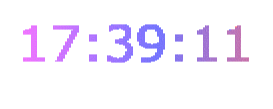
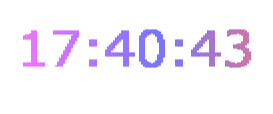
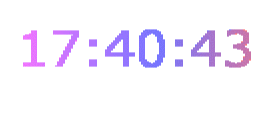
这里我做了四个大家有兴趣可以看完文章,做一个自己喜欢的动画。
思路
开始做之前,我们先分析一下这种粒子动画实现的原理,绘制的内容是由许多个带有颜色像素点构成,每个像素点在画布上都有自己的坐标。首先获取到要绘制的内容的像素点信息的数组(目标数组)例如
[ {x:10, y:20, color: 'rgba(255, 122, 122)'}, {x:11, y:20, color: 'rgba(255, 122, 122)'}, {x:12, y:20, color: 'rgba(255, 122, 122)'}, ]
然后我们就可以让这些像素点从某些特定的位置,以某种特定的方式,移动到目标位置,动画就完成了。
实现
1.获取目标数组
我们先说一下 canvas 的 getImageData() ,该方法返回 ImageData 对象,该对象拷贝了画布指定矩形的像素数据。
对于 ImageData 对象中的每个像素,都存在着四方面的信息,即 RGBA 值:
- R - 红色 (0-255)
- G - 绿色 (0-255)
- B - 蓝色 (0-255)
- A - alpha 通道 (0-255; 0 是透明的,255 是完全可见的)
真实样子是这个样子的
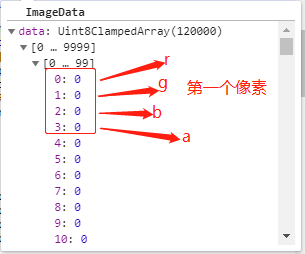
| 0,1,2,3 | 4,5,6,7 | 8,9,10,11 |
| 12,13,14,15 | 16,17,18,19 | 20,21,22,23 |
每四个值为一组,用来表示一个像素点的信息,每一个单元格代表一个像素。
先在一个canvas中绘制想要的内容,通过getImageData()获得像素信息,我们发现ImageData 对象的信息和我们想象中的目标数组不大一样,我们要将ImageData对象处理一下,我们将其每四个划分为一组,重新定义索引,例如我们在一个12px宽的画布中,经过分析不难发现坐标与索引之间的关系,分两种情况 n<12(画布的宽度) 时坐标为((n+1)%12, n+1),n>12时坐标为((n+1)%12, parseInt((n+1)/ 12))
| 0(0,0) | 1(0,1) | .. | n((n+1)%12, n+1) | 11(0,11) |
| .. | .. | .. | .. | .. |
|
n((n+1)%12, parseInt((n+1)/ 12)) |
到这里功能是实现了,但是如果操作的内容很大,像素点很多,后期操作的像素点越多性能就越差,有没有什么办法可以稀释一下这些像素呢,当然有!我们可以隔一个像素取一个像素,这样像素点瞬间就减少了一倍,同理我们隔两个隔三个隔n个,这样我们就可以定义一个参数用来控制像素的稀释度
下面的事情就简单了,用代码实来现这一步
/* * @ ImageDataFormat * @ param { pixels 需要格式化的ImageData对象, n 稀释度 } * @ return { Array } */ function ImageDataFormat(pixels, n){
n = n*4 var arr = [], //目标数组 temPixel = {}, //目标数组中存放像素信息的对象 x = 0, //像素的x坐标 y = 0 //像素的y坐标 for (var i=0;i<pixels.data.length;i+=n){ //过滤纯色背景提高性能,如背景色不可去掉可省略判断 if(pixels.data[i] !== 0 || pixels.data[i+1] !== 0 || pixels.data[i+2] !== 0 ){ var index = (i+1) / 4 //每四个划分为一组,重新定义索引 if(index > timeDom.width){ x = index % timeDom.width y = parseInt(index / timeDom.width) }else{ x = index y = 0 } temPixel = { R: pixels.data[i], G: pixels.data[i+1], B: pixels.data[i+2], A: pixels.data[i+3], I:i, X:x, Y:y } arr.push(temPixel) } }
return arr }
2.将目标数组绘制到画布上
2.1在画布的指定位置画一个圆(一个像素点)
/** * @ drawArc * @ param{ ctx 画布,,x x坐标,y y坐标,color 颜色} */ function drawArc(ctx, x, y, color){ x = x y = y ctx.beginPath(); ctx.fillStyle = color ctx.strokeStyle = color ctx.arc(x,y,0.5,0,2*Math.PI); ctx.closePath() ctx.fill() }
2.1将点连成线,线构成面
/** * 画路径 * @param { points 格式化好的目标数组, crx 画布} */ function draw_path(points, ctx){
for(var i=0;i < points.length-1;i++){
var color = 'rgba(' + points[i].R + ',' + points[i].G + ',' + points[i].B + ')', x, y drawArc(ctx,points[i].X,points[i].Y, color) } }
到此我们就画出了动画的其中一帧,下面我们就要让这一帧动起来
2.2动起来
我们的动画进行其实很简单
1.画第一帧
2.清空画布
3.画下一帧
4.在清空
....
但是想让这个动画流畅的进行起来我们还要在了解一下tween(缓动动画), window.requestAnimationFrame()
tween 我们值列举一种其他 形式感兴趣的可以自己查一下
/* * @ 参数描述 * @ t 动画执行到当前帧所经过的时间 * @ b 起始值 * @ c 总位移值 * @ d 持续时间 */ function easeInOutExpon(t,b,c,d){ if (t==0) return b; if (t==d) return b+c; if ((t/=d/2) < 1) return c/2 * Math.pow(2, 10 * (t - 1)) + b; return c/2 * (-Math.pow(2, -10 * --t) + 2) + b; }
window.requestAnimationFrame()
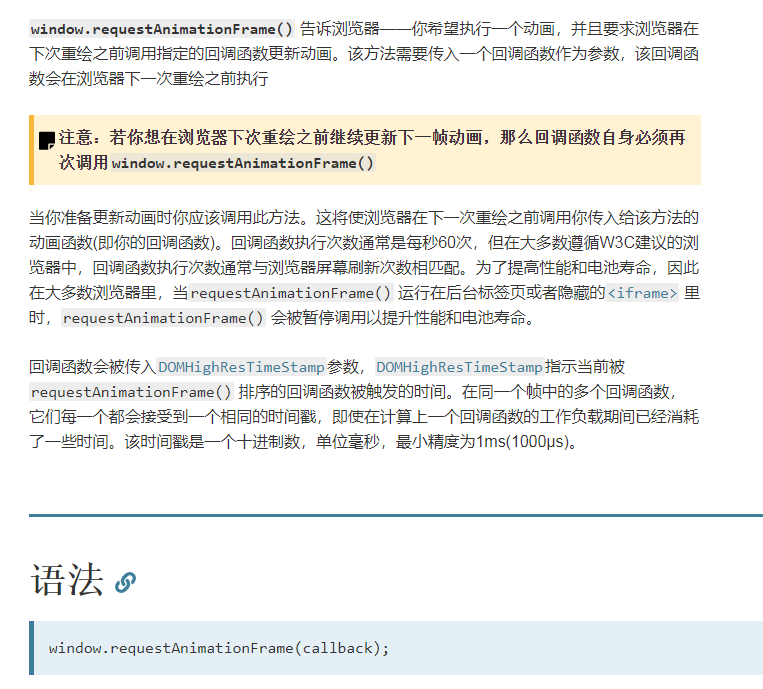
准备工作做好了可以开工了
我么只需要将前面的函数稍微改动一下他就动起来了
function ShowTimeInit(pixels, n){ n = 4*n var arr = [], temPixel = {}, x = 0, y = 0 for (var i=0;i<pixels.data.length;i+=n){ if(pixels.data[i] !== 0 || pixels.data[i+1] !== 0 || pixels.data[i+2] !== 0 ){ var index = parseInt ((i+1) / 4) if(index > timeDom.width){ x = index % timeDom.width y = parseInt(index / timeDom.width) }else{ x = index y = 0 } temPixel = { R: pixels.data[i], G: pixels.data[i+1], B: pixels.data[i+2], A: pixels.data[i+3], I:i, X:x, Y:y } arr.push(temPixel) } } var step = requestAnimationFrame(function(){draw_path(arr, ShowTime, step)}) } /** * 画路径 * @param path 路径 */ function draw_path(points, ctx, step){ ShowTime.clearRect(0,0,ShowTimeDom.width,ShowTimeDom.height); var pointX, pointY, randomX, randomY for(var i=0;i < points.length-1;i++){ switch (mode){ case 'left': pointX = randomNum(0,0) pointY = randomNum(0,100) randomX = 0 randomY = Math.random() + Math.random()*3000 break; case 'center': pointX = 80 pointY = 50 randomX = Math.random() + Math.random()*3000 randomY = Math.random() + Math.random()*3000 break; case 'random': pointX = 0 pointY = 0 randomX = Math.random() + Math.random()*3000 randomY = Math.random() + Math.random()*3000 break; case 'flow': pointX = 0 pointY = 0 randomX = i randomY = i break; } var color = 'rgba(' + points[i].R + ',' + points[i].G + ',' + points[i].B + ')', x, y x = easeInOutExpon(nowDuration + randomX, pointX, points[i].X-pointX, duration) y = easeInOutExpon(nowDuration + randomY, pointY, points[i].Y-pointY, duration) drawArc(ctx,x, y, color) } nowDuration += 1000/60 if(duration <= nowDuration){ window.cancelAnimationFrame(step); }else{ requestAnimationFrame(function(){draw_path(points, ctx, step)}) } }
附上完整代码

<!DOCTYPE html> <html lang="en"> <head> <meta charset="UTF-8"> <meta name="viewport" content="width=device-width, initial-scale=1.0"> <meta http-equiv="X-UA-Compatible" content="ie=edge"> <style> </style> <title>电子时钟</title> </head> <body> <canvas id="HidenTime" width="300" height="100" style="display: none"> </canvas> <canvas id="ShowTime" width="300" height="100"> </canvas> </body> <script> function GetTime(){ this._Hours = '' this._Minutes = '' this._Seconds = '' } GetTime.prototype = { constructor: GetTime, get Hours(){ this._Hours = new Date().getHours() if(this._Hours > 9){ return this._Hours }else{ return "0" + this._Hours } }, get Minutes(){ this._Minutes = new Date().getMinutes() if(this._Minutes > 9){ return this._Minutes }else{ return "0" + this._Minutes } }, get Seconds(){ this._Seconds = new Date().getSeconds() if(this._Seconds > 9){ return this._Seconds }else{ return "0" + this._Seconds } }, formTime:function(){ return this.Hours + ':' + this.Minutes + ':' + this.Seconds } } var requestAnimationFrame = window.requestAnimationFrame || window.mozRequestAnimationFrame || window.webkitRequestAnimationFrame || window.msRequestAnimationFrame; var cancelAnimationFrame = window.cancelAnimationFrame || window.mozCancelAnimationFrame; var duration = 3000, nowDuration = 0 var timeDom = document.getElementById("HidenTime") var time = timeDom.getContext('2d') var ShowTimeDom = document.getElementById("ShowTime") var ShowTime = ShowTimeDom.getContext('2d') time.clearRect(0,0,timeDom.width,timeDom.height); var nowTime = new GetTime() var showTime = nowTime.formTime() var modes = ['left', 'random', 'center', 'flow'] var mode = modes[0] time.font="50px Verdana"; // 创建渐变 var gradient=time.createLinearGradient(0,0,timeDom.width,0); gradient.addColorStop("0","magenta"); gradient.addColorStop("0.5","blue"); gradient.addColorStop("1.0","red"); // 用渐变填色 time.fillStyle=gradient; time.fillText(showTime,10,60); var pixels = time.getImageData(0,0,300,100) ShowTimeInit(pixels, 2) setInterval(function(){ mode = modes[randomNum(0,3)] //mode = modes[3] time.clearRect(0,0,timeDom.width,timeDom.height); nowDuration = 0 showTime = nowTime.formTime() time.fillText(showTime,10,60); pixels = time.getImageData(0,0,300,100) ShowTimeInit(pixels, 2) }, 5000) function ShowTimeInit(pixels, n){ n = 4*n var arr = [], temPixel = {}, x = 0, y = 0 for (var i=0;i<pixels.data.length;i+=n){ if(pixels.data[i] !== 0 || pixels.data[i+1] !== 0 || pixels.data[i+2] !== 0 ){ var index = parseInt ((i+1) / 4) if(index > timeDom.width){ x = index % timeDom.width y = parseInt(index / timeDom.width) }else{ x = index y = 0 } temPixel = { R: pixels.data[i], G: pixels.data[i+1], B: pixels.data[i+2], A: pixels.data[i+3], I:i, X:x, Y:y } arr.push(temPixel) } } var step = requestAnimationFrame(function(){draw_path(arr, ShowTime, step)}) } /** * 画路径 * @param path 路径 */ function draw_path(points, ctx, step){ ShowTime.clearRect(0,0,ShowTimeDom.width,ShowTimeDom.height); var pointX, pointY, randomX, randomY for(var i=0;i < points.length-1;i++){ switch (mode){ case 'left': pointX = randomNum(0,0) pointY = randomNum(0,100) randomX = 0 randomY = Math.random() + Math.random()*3000 break; case 'center': pointX = 80 pointY = 50 randomX = Math.random() + Math.random()*3000 randomY = Math.random() + Math.random()*3000 break; case 'random': pointX = 0 pointY = 0 randomX = Math.random() + Math.random()*3000 randomY = Math.random() + Math.random()*3000 break; case 'flow': pointX = 0 pointY = 0 randomX = i randomY = i break; } var color = 'rgba(' + points[i].R + ',' + points[i].G + ',' + points[i].B + ')', x, y x = easeInOutExpon(nowDuration + randomX, pointX, points[i].X-pointX, duration) y = easeInOutExpon(nowDuration + randomY, pointY, points[i].Y-pointY, duration) drawArc(ctx,x, y, color) } nowDuration += 1000/60 if(duration <= nowDuration){ window.cancelAnimationFrame(step); }else{ requestAnimationFrame(function(){draw_path(points, ctx, step)}) } } /** * 画圆 */ function drawArc(ctx, x, y, color){ x = x y = y ctx.beginPath(); ctx.fillStyle = color ctx.strokeStyle = color ctx.arc(x,y,0.5,0,2*Math.PI); ctx.closePath() ctx.fill() } /* * 参数描述 * t 动画执行到当前帧所经过的时间 * b 起始值 * c 总位移值 * d 持续时间 */ function easeInOutExpon(t,b,c,d){ if (t==0) return b; if (t==d) return b+c; if ((t/=d/2) < 1) return c/2 * Math.pow(2, 10 * (t - 1)) + b; return c/2 * (-Math.pow(2, -10 * --t) + 2) + b; } //生成从minNum到maxNum的随机数 function randomNum(minNum, maxNum) { switch (arguments.length) { case 1: return parseInt(Math.random() * minNum + 1, 10); break; case 2: return parseInt(Math.random() * ( maxNum - minNum + 1 ) + minNum, 10); break; default: return 0; break; } } </script> </html>
总结
当一个新想法出现时,先去github和博客上找一找,看看有没有大佬做过,大佬们的的思路是什么,有什么自己没想到的细节,感觉差不多了在动手去做。
